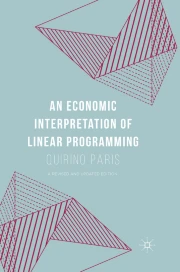
This is a preview of subscription content, log in via an institution to check access.
Hardcover Book EUR 105.49
Price includes VAT (France)Tax calculation will be finalised at checkout
This text covers the basic theory and computation for mathematical modeling in linear programming. It provides a strong background on how to set up mathematical proofs and high-level computation methods, and includes substantial background material and direction. Paris presents an intuitive and novel discussion of what it means to solve a system of equations that is a crucial stepping stone for solving any linear program. The discussion of the simplex method for solving linear programs gives an economic interpretation to every step of the simplex algorithm. The text combines in a unique and novel way the microeconomics of production with the structure of linear programming to give students and scholars of economics a clear notion of what it means, formulating a model of economic equilibrium and the computation of opportunity cost in the presence of many outputs and inputs.
“This book is suitable for anyone who wants to study LP and its applications, especially in economics. The content of the book is well structured in order to help readers understand the concepts of LP. … this is must-read book for anyone who wants to thoroughly study LP, its economic interpretation and the theorems behind the concepts.” (Dharma Lesmono, Mathematical Reviews, September, 2018)
“This book, divided in 21 chapters, studies in great extent the field of linear programming with an emphasis to its applications and the economic interpretation of the problem statement and results. … This book is very easy to follow and presents an excellent overview of the field of linear programming bothfor first time readers and for experienced researchers in the field.” (Efstratios Rappos, zbMATH 1364.90001, 2017)
"An Economic Interpretation of Linear Programming is a serious and meaningful revision of an already excellent book. It provides a refreshing and thoroughly unique perspective on linear programming that is imbued with Paris's characteristic passion for economics in general, and duality and symmetry in particular - beautiful is the word that comes to mind!" - Michael R. Caputo, Professor of Economics, University of Central Florida, USA
"Paris's articulation of economic interpretations for mathematical structures is his forte and this book exceeded my expectations. The primary struggle for my students is not mastery of technical aspects but rather the application of those concepts to economic problems. This book's presentation of opportunity cost, relevant examples, and practice exercises will greatly assist students in making these connections. Furthermore, it is accomplished without sacrificing rigor." - Ken Foster, Professor and Head of the Department of AgriculturalEconomics, Purdue University, USA
"This book contains most of what there is to know about linear programming - and, for most readers, about the main lines of economic thought. It is intuitive, clear, and orderly. Paris takes the reader on a walk through the world of linear models: their construction, trouble-shooting, and interpretation. Examples are intuitive and plentiful. The duality theme simplifies everything." - Steven Buccola, Emeritus Professor of Applied Economics, Oregon State University, USA
"Paris provides us with a revised edition of his classic linear programming text that demonstrates the value, relevance, and power of this optimization problem to sophisticated applications of economic theory. The defining contribution is Paris's keying in on the two faces of the optimization problem: primal and dual. By orienting the presentation on the dual perspective of this class of optimization problems and the symmetry between the two faces, this book demonstrates that optimization and duality have a natural affinity for microeconomic analysis. The economic interpretation of the dual perspectives is often central to illuminating economic relationships. While there are arguably no new ideas under the sun, this book is in the class of contributions showing that beauty emerges in how you put these ideas together to teach us something new, exciting, and useful." - Spiro E. Stefanou, Professor and Chair of the Food and Resource Economics Department, University of Florida, USA
Quirino Paris spent his entire academic career at the University of California, USA, earning a PhD from Berkeley in 1966 and serving as Professor of Agricultural Economics at UC Davis from 1969. In 2011 he published a companion book titled Economic Foundations of Symmetric Programming. He is a Fellow of the American Applied Economic Association and of the European Association of Agricultural Economists.